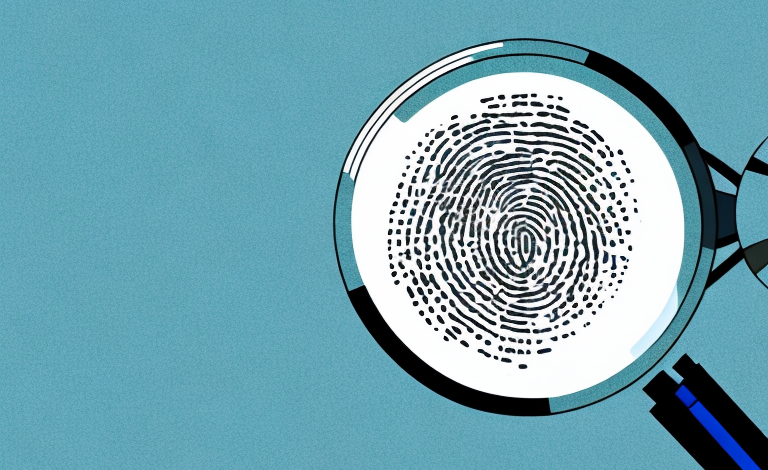Fingerprints are unique patterns found on the tips of our fingers. They have been used to identify individuals for over a century due to their complexity and permanence. While it is generally believed that even a small portion of a fingerprint can be used for identification, the question remains: how much of a fingerprint is needed to make a match? In this article, we will explore the science behind fingerprint analysis and the factors affecting its accuracy.
Understanding Fingerprint Matching: An Overview
Fingerprint matching involves comparing the patterns of ridges and valleys on a known print, called an exemplar, with a latent print found at a crime scene. The goal is to determine whether the two prints came from the same finger. This process is done manually by a trained examiner or using automated systems.
Manual fingerprint matching involves a trained examiner visually comparing the patterns on the exemplar and latent prints. The examiner looks for similarities in the ridge characteristics, such as the number of ridges, their shape, and their location. Automated systems use algorithms to compare the prints and generate a similarity score.
Fingerprint matching is a crucial tool in forensic investigations. It can help identify suspects, link crimes, and exonerate innocent individuals. However, it is not foolproof, and errors can occur. Factors such as poor quality prints, human error, and technical limitations of the equipment can affect the accuracy of the results. Therefore, it is essential to use fingerprint matching as part of a broader investigation and consider other evidence to make informed decisions.
The Science of Fingerprint Analysis
Fingerprints are formed during fetal development and remain unchanged throughout a person’s life, barring any injuries or conditions that affect the skin. The patterns are unique to each individual, and no two people share the same set of prints. This makes fingerprints a reliable means of identification in forensic investigations.
Fingerprint analysis involves the comparison of two sets of prints to determine if they belong to the same person. This is done by examining the ridge patterns, minutiae, and other characteristics of the prints. The process can be done manually or with the help of computer software. Fingerprint analysis is widely used in criminal investigations, but it is also used in other fields such as immigration and background checks.
The Role of Fingerprints in Forensic Investigations
Fingerprints are one of the most common types of evidence found at crime scenes. They can be lifted from a variety of surfaces, including skin, paper, and glass. They are also used to identify suspects and eliminate innocent individuals from investigations.
One of the reasons fingerprints are so valuable in forensic investigations is that they are unique to each individual. Even identical twins have different fingerprints. This means that if a fingerprint is found at a crime scene, investigators can compare it to a database of known fingerprints to identify a suspect.
In addition to their use in criminal investigations, fingerprints are also used for other purposes. For example, many countries require fingerprints for identification when applying for a passport or visa. Fingerprint technology is also used in some workplaces to track employee attendance and prevent fraud.
Factors Affecting Fingerprint Matching Accuracy
The accuracy of fingerprint analysis depends on several factors. The quality and clarity of the exemplar prints, the condition of the latent prints, and the experience and skill of the examiner all play a role in determining the accuracy of the match. Environmental factors such as temperature and humidity can also affect the quality of prints.
Another factor that can affect fingerprint matching accuracy is the presence of injuries or scars on the fingers. These can alter the ridge patterns and make it more difficult to match prints accurately. Additionally, the age of the prints can also impact accuracy, as older prints may have degraded or been contaminated over time. It is important for examiners to take all of these factors into consideration when analyzing fingerprints for forensic purposes.
Different Techniques for Fingerprint Analysis
Various techniques can be used to analyze fingerprints, including traditional methods such as powder or chemical treatments and modern techniques such as digital imaging and laser scanning. Each method has its own strengths and limitations, and the choice depends on the circumstances of the investigation.
One traditional method of fingerprint analysis is the use of ninhydrin, a chemical that reacts with amino acids in sweat to produce a purple color. This method is particularly useful for analyzing fingerprints on porous surfaces such as paper or cardboard.
Another modern technique is the use of magnetic powder, which is applied to a surface and then lifted with a special tape to reveal the fingerprint. This method is particularly useful for analyzing fingerprints on non-porous surfaces such as glass or metal.
How to Collect and Preserve Fingerprints for Analysis
The collection and preservation of fingerprints is a critical step in the investigation process. Proper techniques must be used to prevent contamination or damage to the prints. The prints must be stored in suitable conditions to prevent deterioration or loss of detail.
One of the most important steps in collecting fingerprints is to ensure that the surface from which the print is being lifted is clean and free of any debris. Any foreign material on the surface can interfere with the clarity of the print and make it difficult to analyze. It is also important to use the correct lifting technique, such as dusting with fingerprint powder or using adhesive tape, to avoid damaging the print.
Once the prints have been collected, they must be carefully preserved to prevent any deterioration. This can be achieved by storing them in a cool, dry place, away from direct sunlight or moisture. It is also important to handle the prints as little as possible to avoid any damage or contamination. In some cases, it may be necessary to use specialized preservation techniques, such as vacuum-sealing or chemical treatment, to ensure the longevity of the prints.
Advances in Fingerprint Matching Technology
The field of fingerprint analysis has seen many technological advancements in recent years, including automated systems that can scan and match prints within seconds. These systems offer increased speed and accuracy and have revolutionized the field of forensic investigation.
One of the most significant advancements in fingerprint matching technology is the use of artificial intelligence (AI) algorithms. These algorithms can analyze and compare fingerprints with a level of accuracy that surpasses human capabilities. They can also identify patterns and features that may be missed by human analysts, leading to more accurate identifications and faster investigations.
Another area of development in fingerprint analysis is the use of 3D imaging technology. This technology allows for a more detailed and accurate capture of fingerprints, including the ridges and valleys that make each print unique. This can be especially useful in cases where the print is distorted or incomplete, as the 3D image can provide additional information for analysis.
Current Challenges and Limitations of Fingerprint Matching
Despite ongoing advancements, fingerprint analysis is not foolproof. Human error, sample contamination, and limitations in technology can all lead to errors in matching or false identifications. There is also ongoing debate about the reliability of fingerprint evidence in court cases.
One of the major challenges in fingerprint matching is the quality of the fingerprint sample. Poor quality samples, such as those with smudges or partial prints, can make it difficult to accurately match fingerprints. Additionally, certain factors such as age, skin condition, and occupation can affect the quality of the fingerprint, making it more difficult to obtain a clear and accurate match.
Another limitation of fingerprint matching is the potential for bias. Studies have shown that certain factors, such as race and gender, can influence the accuracy of fingerprint analysis. This has raised concerns about the potential for discrimination in the criminal justice system, and has led to calls for more rigorous standards and oversight in the use of fingerprint evidence.
Legal Implications of Fingerprint Analysis
Fingerprint evidence is admissible in court and has been used to secure convictions in numerous cases. However, the reliability and accuracy of fingerprint analysis are often subject to scrutiny by defense attorneys. It is crucial that the collection, handling, and analysis of fingerprint evidence are performed properly and ethically to prevent wrongful convictions.
One of the challenges with fingerprint analysis is the potential for human error. Fingerprint examiners must undergo extensive training and certification to ensure that they are able to accurately analyze and compare prints. However, even with proper training, mistakes can still occur. In some cases, examiners may be biased towards finding a match, leading to false identifications.
Another issue with fingerprint analysis is the possibility of contamination. Fingerprint evidence can easily be transferred from one surface to another, and if proper precautions are not taken during collection and handling, the evidence may be compromised. It is important for law enforcement agencies to have strict protocols in place for the collection and preservation of fingerprint evidence to ensure its reliability in court.
Future Directions in Fingerprint Matching Research
The field of fingerprint analysis continues to evolve, and researchers are continually exploring new methods and techniques to improve the accuracy and speed of matching. Advances in technology such as machine learning and artificial intelligence may offer even greater abilities to identify and match prints in the future.
In conclusion, while it is generally believed that even a small portion of a fingerprint can be used for identification, the accuracy of fingerprint analysis is affected by many factors. Advances in technology have greatly improved the speed and accuracy of fingerprint matching, but there are still challenges and limitations to be overcome. Proper collection, preservation, and analysis of fingerprints are critical to ensuring that the evidence is admissible in court and leads to just outcomes.
One area of future research in fingerprint matching is the use of 3D imaging technology. This technology can capture more detailed information about the ridges and valleys of a fingerprint, which may improve accuracy and reduce the likelihood of false matches. Additionally, researchers are exploring the use of chemical and biological techniques to enhance the visibility of latent fingerprints, which could lead to more successful identifications in cases where traditional methods have failed.



